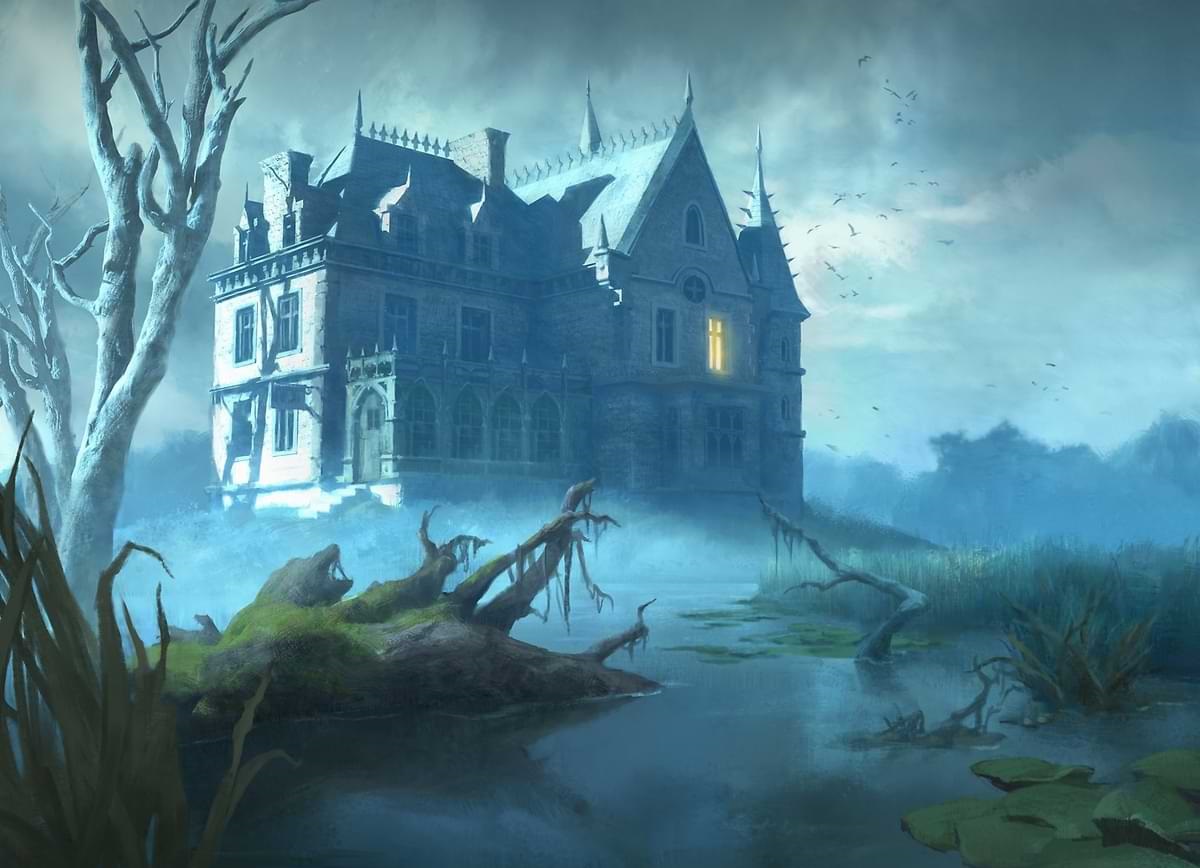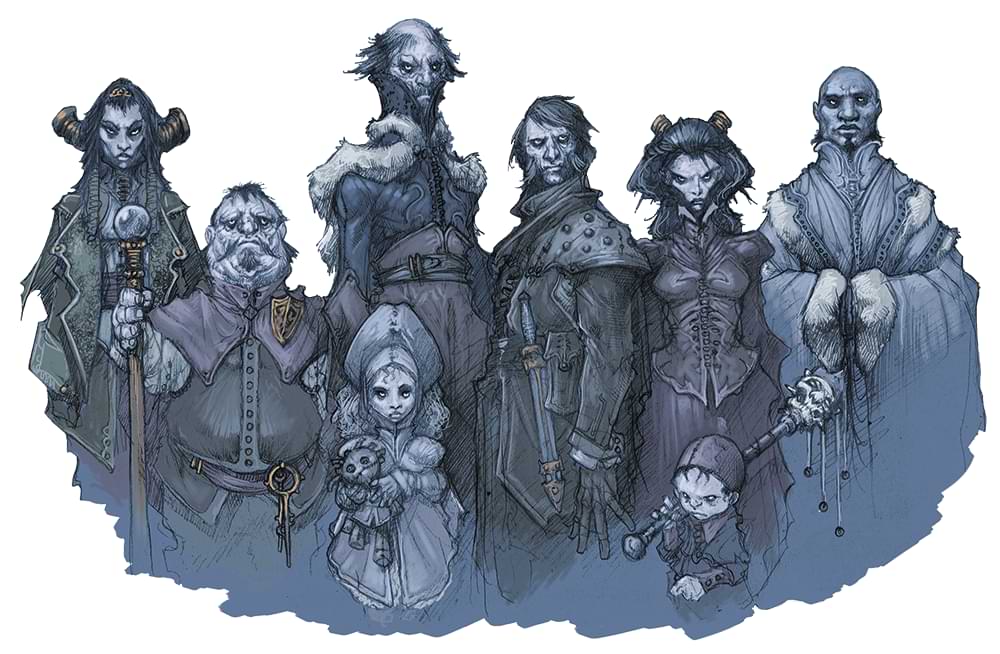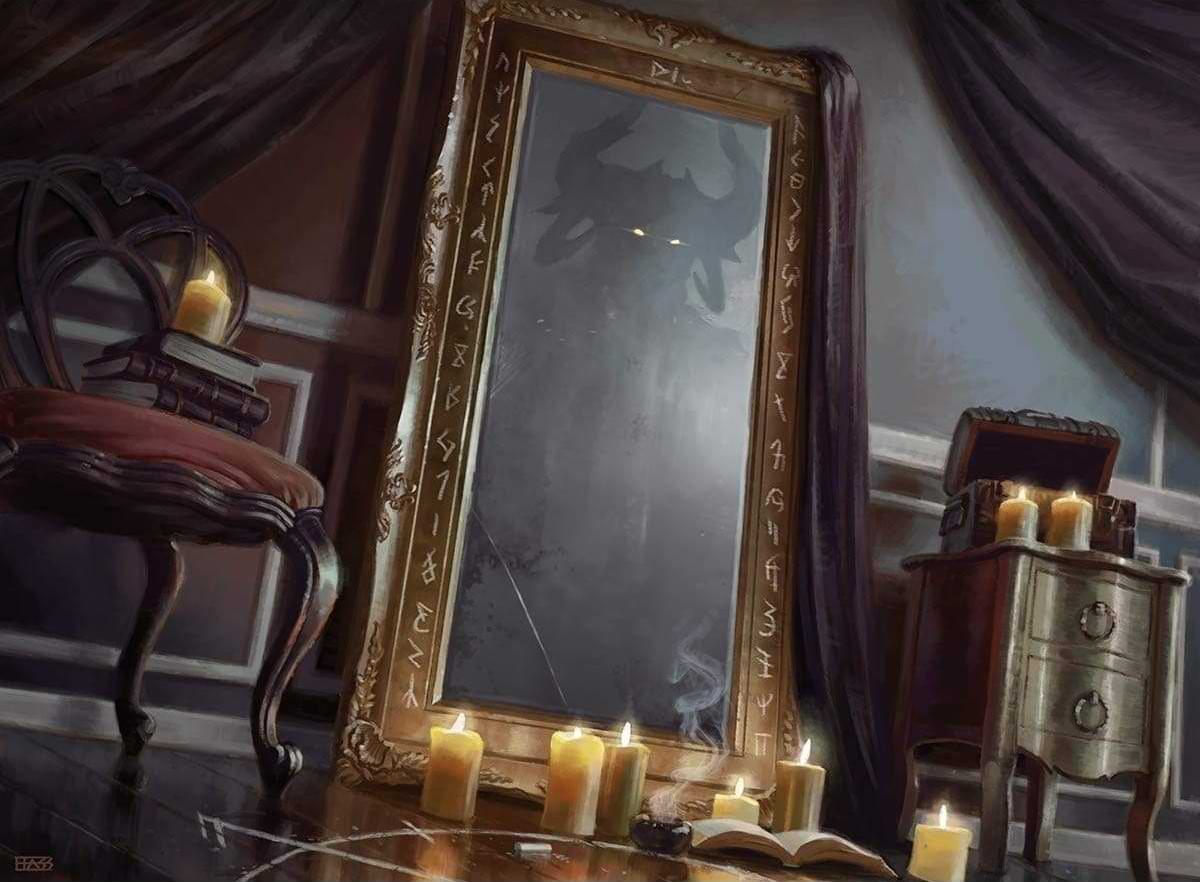Last Halloween, you got your friends together—it was finally time for some scary D&D. You dimmed the lights, donned your favorite black shirt, and unleashed Strahd. You even did that awesome trick where you lit your face with a flashlight for the entire game. But not a trace of terror could be found at your table.
If you want to take another swing at scary this Halloween, here are five fun tips to make your Dungeons & Dragons game spookier.
- A fundamental rule in horror
- Find fear in the familiar
- Twist the tropes of the game
- Personalize your story’s horror
- Let your players fill the gaps
- Keep them guessing in combat
Pulling Back the Rubber Band: A Fundamental Rule in Horror
Horror and comedy share a similar principle: They each aim to shatter preconceived notions. A preconceived notion is an understanding or expectation of what’s going to happen. Comedy is supposed to do it without causing fear or discomfort. But horror is meant to scare you.
Let’s look at an example. Your math teacher calls on you in class to solve an equation. What would normally happen next? Say it out loud right now, on the toilet while you read this on your phone. That’s your preconceived notion.
Your math teacher calls on you in class to solve an equation. You answer it correctly, but she shakes her head! “Incorrect!” A pause. “Not!” Everyone laughs, shocked because she’s often serious but is now slinging 90s era comedy!
A different take on the same example: Your math teacher calls on you in class to solve an equation. You answer it correctly, but she just … stands there, staring at you. She's so still, it’s hard to tell if she’s even breathing. But her eyes don’t leave you. Suddenly, the bell rings. She snaps back to normal, as if waking from a deep sleep. Everyone hustles out of class, shaken.
The latter scenario is a great example of building tension, or pulling back the rubber band. Tension can be defined as both intense fear or suspense, as well as a state of being stretched or strained. The long beat of your teacher staring at you is the building of tension, the rubber band being pulled back. The bell ringing is letting the rubber band go. If you don’t pull the rubber band back far enough, it won’t fly. If you pull it too far, it can snap.
Experiment with pulling back the rubber band. You'll start to get a good sense of how far to pull it back, how long, and when to change things up. In D&D, this can be challenging. The rubber band doesn’t just apply to characters in a scary scene, it applies to your players! They are simultaneously the characters in the horror movie and the audience watching. With enough play, you’ll get comfortable terrorizing them on both levels.
And finally, there’s good ol’ repetition. Repetition is how we establish preconceived notions and patterns. You know that your math teacher usually just drones out "Correct" or "Incorrect” and then moves on. It’s happened over and over again. That’s why it freaked you out when she just … stared.
Find Fear in the Familiar
 To have a preconceived notion of a location, your players first need to be familiar with it. So, allow them to explore areas and let them get comfortable before using their knowledge against them. A mysterious thunk inside of an abandoned house isn’t all that scary if we just walked into it for the first time—we just got here! Maybe a thunk is normal! But if we’re somewhere familiar, and there’s a thunk where we know there shouldn’t be one, that's a different story. This breaks our preconceived notion of how things should be.
To have a preconceived notion of a location, your players first need to be familiar with it. So, allow them to explore areas and let them get comfortable before using their knowledge against them. A mysterious thunk inside of an abandoned house isn’t all that scary if we just walked into it for the first time—we just got here! Maybe a thunk is normal! But if we’re somewhere familiar, and there’s a thunk where we know there shouldn’t be one, that's a different story. This breaks our preconceived notion of how things should be.
Directors James Wan and Mike Flanagan do a wonderful job with getting their audience familiar with a space in their horror work—and prove that location exposition doesn’t have to be complicated. From a family moving into a house for the first time in The Conjuring, to a resident giving a newcomer a tour of the space in The Haunting of Bly Manor, both the characters and audience find a sense of the familiar within a location, and unconsciously establish preconceived notions about it.
Again, in D&D, your players are the characters and the audience. Once they’re familiar with a person, place, or thing, it’s your time to strike. The mysterious thunk is a lot scarier when you know it’s coming from the youngest son’s bedroom, and that he died last year. Once your players are confident that the staircase leads to the cellar, change that detail. Now the stairs lead to a bedroom full of cobwebs and an ominous portrait.
House of Lament is a great adventure that plays with this concept. The adventurers are tasked with investigating a mysterious manor. Give your players an extra night to wander about the location before things start to escalate.
What if your game is short on time, and learning a new location isn’t in the cards? Does your party have a home base or a regular hang? Put the scary in there—a place they feel they have control over, a place they know should be safe.
Twist the Tropes of the Game
You’ve already established patterns when you play D&D with your friends. You call for Perception checks and give results. You ask everyone to roll for initiative!
These are patterns that are all up for grabs when you’re trying to instill an element of fear at your table. Remember when we talked about the rubber band being affected by both the characters in your story and the audience playing them? Here's where it can be fun and work to your advantage.
At the top of my one-shots, everyone typically gets to do their character introductions. As the DM, I guide our attention to the library, and then a player takes over: “At the library, you see Jim Corker, a human fighter. He’s clearly a sailor, clearly drunk, and clearly thinks he’s at the bar.” Everyone laughs. I guide us across the street, where we meet the next character.
Before the next player can introduce their character, though, I ask them to make a Perception check. That’s weird—we're like, already playing? They now have to introduce their character knowing something is amiss. They are not alone, the danger has already begun. This changes the mood at the table. The film 28 Days Later introduces its lead as he's discovering that he is completely alone, and that something is very, very wrong. Choices like this break the preconceived notion of what the beginning of a game should be and sets the tone for an intense session.
Speaking of, how often do we ask for Perception checks? Pick your moment, and instead of merely saying it succeeds or fails, ask them: “With that high of a roll, how did you not hear that?” Leave them wondering what they missed.
In a similar vein, everyone has their own variation of "How do you want to do this?” It’s a celebratory moment when a monster dies. It’s a release of the rubber band—we're victorious, we’re safe! That’s when the dead monster grabs the leg of the character who just cut it in half.
D&D is a blend of storytelling elements and social interaction. Mess with them both! Get creative! Can you turn long rests against your players? Insight checks? Don’t do it every time, of course. Use repetition to lure your players in, and test that rubber band to see what works best!
Personalize Your Story’s Horror
Stakes should be personal. There’s usually a reason a family can’t leave the haunted house. There’s a reason why your characters feel it’s worth it to either kill or be killed by a demon. There’s a reason we’re crossing this zombie wasteland—there's a city that the virus hasn’t touched! Your tragically missing husband might be there!
While the Domains of Dread—the nightmare demiplanes that form the Ravenloft setting—offer endless frameworks for fear, it’s important to fill those frameworks with personal stakes. If you have a player desperate to get some backstory shared with the table, your horror game is the perfect opportunity. After all, what’s better than your player revealing that they’re searching for their lost mom? A mysterious message that says she’s taken up residence with a lord in a strange land called Barovia.

Or maybe you have a player who is always down to be a little extra? Well, they picked up the wrong puzzle box and are slowly being possessed by a demon. It’s up to the party to discover the secrets of a strange catacomb, lest they watch their friend at the table be consumed by evil. In The Mothman Prophecies, the protagonist is drawn to the monster because he believes it could connect him with a lost loved one. This leads the protagonist to spiral. What a delightfully spooky gift to give the player at your table itching to stretch their acting chops!
Let Your Players Fill in the Gaps

It happens to all of us: We're watching a horror movie, and what’s pictured in our head is so scary, the monster reveal is a total letdown. D&D is no different. In fact, the impact could be even bigger, because your players are imagining every bit of the story you’re unraveling with them.
So, let them do the heavy lifting sometimes. Let them describe what the evil forest looks like. If they describe something you like, seize it as a weapon for your own use! Oh, your player said that the recent rainfall dripping from the leaves of the trees looks like blood? Roll Perception, gang. It’s blood.
I also love letting players take the wheel when describing their characters' dreams. In fact, focus on a single player. Make that dream recur. Let the table get used to the repetitive beats of the dream. Trick them into a pattern. Pull the rubber band enough, and gently take over the dream. The faceless man on the throne isn’t there this time. Instead, it’s one of your party members, laughing at you. Or, if you’re a fan of jump scares, Whoops!, the faceless man is right behind you!
Keep Them Guessing in Combat
The important thing about horror is the lasting impact it has on a character. Combat, especially at low levels, is often not particularly impactful (see bandit, fight bandit, kill bandit). Taking the basics a step or two further can pay off.
A monster deals psychic damage. What does that mean, exactly? A brief migraine? Or do you leave combat entirely, walking a character through a nightmare of their own description while the psychic damage tears through their mind?
When it comes to horror in combat, nothing is ever simple, fair, or as it seems. Slashers in masks always get up, and no terrain is easy to cross. Visibility is always obscured. And sometimes, things just don’t make any sense: Initiative gets rolled to fight a simple brigand—no threat to your high-level party—but no matter how much damage they inflict, he keeps coming. He won’t stop. In fact, he bemoans the fact that killing you is the only way this ends. You’ve killed him now dozens of times over, but it just won’t end.
Why? No clue. Is it a particular spell from the Player’s Handbook? Not necessarily. When DMing a D&D horror game, heighten the moment and twist the rules however you need to, rules or not! Just because some nerd in a Wes Craven movie knows all the rules to scary movies doesn’t mean that your players understand the rules to your scary game. So, be creative and attentive!
Let's Get Spooky
Hopefully you find something here you like for Halloween! Horror can be tough to crack in D&D, but it’s incredibly rewarding for a table that’s on board for a spooky night. Have fun, and if it doesn’t always go according to plan, you’ll get them next time!
Joe Starr (@joestarr187) is the content manager for D&D Beyond. Previously, he wrote for the web series Honest Trailers, for which he lost multiple Emmys to James Corden. He’s not bitter and has worked it out with his therapist. His favorite D&D hobby is obsessively perfecting the build for his dhampir barbarian/fighter and variant human fighter/ranger/rogue.








-
View User Profile
-
Send Message
Posted Oct 14, 2022Love this article, Joe.
To others reading, I can't recommend watching House of Lament highly enough!
-
View User Profile
-
Send Message
Posted Oct 14, 2022now i know that they're spying on me. "Let’s look at an example. Your math teacher calls on you in class to solve an equation. What would normally happen next? Say it out loud right now, on the toilet while you read this on your phone. That’s your preconceived notion." *Reading while on toilet* good article though, keep up the good work
-
View User Profile
-
Send Message
Posted Oct 14, 2022Third!
-
View User Profile
-
Send Message
Posted Oct 15, 2022AMAZING article, this is so helpful for someone who wants to run a horror game but doesn’t consume horror media pretty much ever. I’m already brimming with ideas *evil laugh*…
-
View User Profile
-
Send Message
Posted Oct 15, 2022Take ordinary mundane things and make them unusual, just enough to ire suspicion and when someone tries to bring attention to it, have it disappear placing potential doubt on the suspicion. Paranoia among players is a strong way to build up tension.
-
View User Profile
-
Send Message
Posted Oct 15, 2022This is really inspiring and helpful. I feel it really helped me broaden my horizon about how to deliver the unease I want to bestow to my friends.
-
View User Profile
-
Send Message
Posted Oct 16, 2022What an amazing article, I’ll be sure to use some of these ideas in the future… the scheming has already begun…
-
View User Profile
-
Send Message
Posted Oct 16, 2022I've read way too many books on writing and running horror, and this basically encapsulates most of them in a fraction of the word count.
Great job.
-
View User Profile
-
Send Message
Posted Oct 17, 2022better then whatr the ravenlot book suggestet
-
View User Profile
-
Send Message
Posted Oct 17, 2022This is really fun! I especially love the notes on breaking up what characters expect of the game mechanics, rather than just internal game logic.
-
View User Profile
-
Send Message
Posted Oct 17, 2022I haven't even DMed before, and I don't even like horror, but this is definitely making me want to run a horror game. I already have so many ideas for how to twist common monsters and make them absolutely horrifying. I'll most likely be using some or all of these when I inevitably run a oneshot or two, the planning has already begun...
-
View User Profile
-
Send Message
Posted Oct 17, 2022cool
-
View User Profile
-
Send Message
Posted Oct 18, 2022Please stop, our DM already scared us enough with the psychological horror post you made
-
View User Profile
-
Send Message
Posted Oct 18, 2022Perfect timing :)
-
View User Profile
-
Send Message
Posted Oct 18, 2022This article is so good! I lIke all of the combat suggestions and I’m definitely going to use them. I also like how you mentioned that characters need to explore the setting. Players will feel less connected to the setting if you just straight up tell them everything without them looking for it. So, they look for it, they find something, but it still feels off, like they’re missing something, like there is one shadow they haven’t checked, but they don’t know where it is! That’s what I love about games like this.
-
View User Profile
-
Send Message
Posted Oct 19, 2022Such a well written article! Thank you
-
View User Profile
-
Send Message
Posted Oct 19, 2022I just read this in the middle of the night, so extra spook points for you! :)
Very good article.
-
View User Profile
-
Send Message
Posted Oct 21, 2022This has been so helpful to me. Love it Love it Love it!!
-
View User Profile
-
Send Message
Posted Oct 21, 2022Great article!
I found a great grim dark slaughterhouse adventure for those looking for a horror setting. It's even filled with cannibal cultists, so most of the work seems to be done!
https://cultadventures.com/product/marked-for-slaughter-dnd-5e-slaughterhouse-adventure/
-
View User Profile
-
Send Message
Posted Oct 23, 2022Remember: you are not trying to scare the characters. You are trying to scare the players.